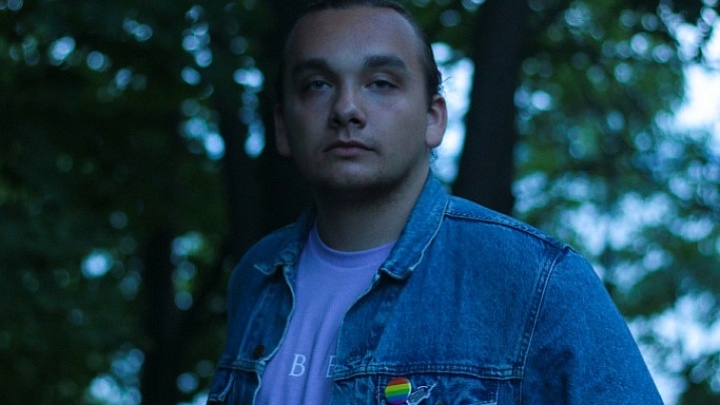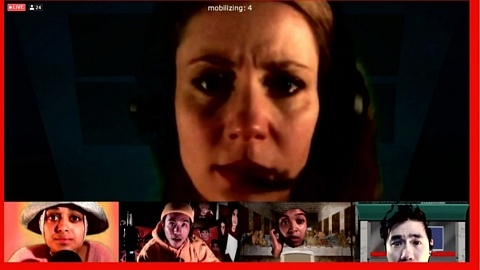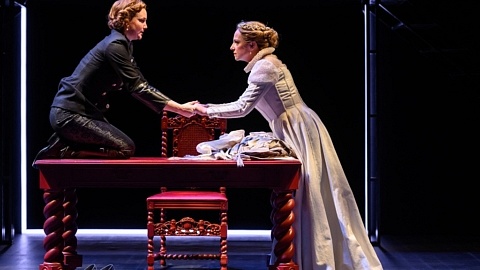Rick Roberts’ Orestes, directed by Richard Rose, confronts the progressively blurring lines between real life and virtual life in a heightened version of the...
Little Eagle takes flight: Cole Forrest’s The Heels of our Grandfathers at In the Soil
By Leah Eichler
Who am I?
The need for self-identification and self-actualization is an experience that many of us can relate to.
The Heels of Our Grandfathers by Cole Forrest (pictured above) tells this story from the viewpoint of an Ojibwe youth, Little Eagle, on the cusp of adulthood. Par for the course for someoneat that stage in life, Little Eagle is caught in all sorts of turmoil. They receive strife from the colonialist world around them and from their family. They are called “little Indian” and targeted for fist-fighting violence when they leave the safety of the reserve to hang out with non-reserve teenagers. As a two-spirited drag queen, they get into constant arguments with their own mother, a victim of domestic abuse herself, who – in a cycle of violence – raises her frying pan against her child. All the while, all Little Eagle wants to do is find their place in the world. To have the love and acceptance of their mother. To dance at the upcoming Pow-Wow in full drag and feel powerful instead of ostracized.
The Heels of Our Grandfathers has truly wonderful moments of human connection. Little Eagle explains their strained relationship with their mother. Though her abusive husband (Little Eagle’s father) is now gone, his deeds cast a shadow on the family. Little Eagle and their mother “constantly tear away at each other’s wings”, as Forrest’s character puts it. Despite this, mother and child still love each other so, so deeply, and want to fix their dysfunctional relationship. They find solace in each other as often as they maim one another with their actions.One example of the heart of their relationship is when Little Eagle’s mother drives to pick them up after they had gotten into a fight; she explains why she does this, brusquely yet emotionally: “You’re my child.” This, I think, is an extremely honest representation of the connections between people, and struck hard as I sat in my seat, watching Forrest perform. A second truly striking moment is towards the end, when Little Eagle begins to dance at their community’s Pow-Wow. They are dressed in the way that makes them feel the most powerful, and the most like themselves: in a skirt, heels, and makeup. They describe how they feel the wind under their multi-coloured wings, and how those wings are vibrant and shine so brightly. It is a culmination of the trials they have gone through to reach this point, and it is a warm, proud moment.
The overarching narratives of The Heels of Our Grandfathers are strong. Where the piece could be strengthened, however, is in how those narratives are told. There are multiple storylines intercrossing with each another throughout the show. While there are strong beginnings to these stories and strong endings, the middle details are extremely murky.Little Eagle goes from hiding their inclination towards drag and fighting with their mother about it to abruptly dressing up to dance at the Pow-Wow, with very little explanation between.This meant that many of the finer details of thematic elements were lost, and that much of the time I was attempting to make sense of what I had just seen.
Overall, The Heels of Our Grandfathers could use refinement and editing.Forrest is both the writer and performer of the show, and presumably directed themselves, as the only other artistic personnel listed on the In the Soil website are Austin Lindsay, the stage manager, and Katie Couchie, the production designer.The piece could use an outside eye for editing purposes. But the pieces of the puzzle are there. The framework is there. The story, the human connection, the heart is there. Cole Forrest does a wonderful job of connecting to the authenticity of their workthrough their believable emotional investment, and translating that into a performance, and I look forward to seeing where they go next.
Related Posts
Every year the University of Windsor School of Dramatic Art produces multiple plays featuring its fourth-year students. This year, under the circumstances of...
“You must take your rightful place as Queen.”
What a refreshing line to hear after countless stories about men murdering each other for a crown, men waging...
Every year the University of Windsor School of Dramatic Art produces multiple plays featuring its fourth-year students. This year, under the circumstances of...
“You must take your rightful place as Queen.” What a refreshing line to hear after countless stories about men murdering each other for a crown, men waging...
Leave a Reply (Cancel Reply)
Twitter Feed
Blogroll
DARTcritics.com is partially funded by the Marilyn I. Walker School of Fine and Performing Arts, in support of student learning; experiential education; student professionalization; public engagement with the teaching, learning and production activities of the Department of Dramatic Arts; new ways of thinking; and the nurturing of links with our communities.





